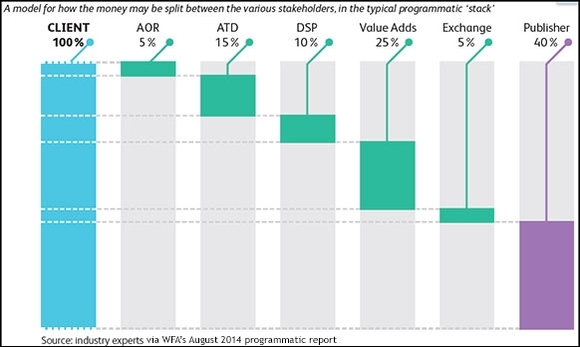Commentary
Where Your Money Goes In The Programmatic 'Stack'
- by Tyler Loechner , Staff Writer @mp_tyler, September 5, 2014

In addition to this week releasing guidance helping brands navigate the programmatic waters, the World Federation of Advertisers (WFA) also asked
"industry experts" to spell out where their money goes as it weaves it’s way through the programmatic “stack.”
Note: these figures are rounded and rough averages of the “typical” programmatic buy. Programatic campaigns can differ, obviously, but this gives us a good look at how the money is realistically divvied up -- something marketers might not actually know.
Mark Butterfield, head of global media at Boehringer Ingelheim, commented in the study: “We have little or no clear understanding of what percentage (of digital spend) is being delivered to the media owner and what is being taken in fees from either the agency or middle men. There needs to be clarity in the value chain otherwise clients will continue to question the validity of the digital buy.” Butterfield is a member of the WFA programmatic task force, which includes executives from other big brands such as Coca-Cola, Johnson & Johnson and MasterCard.
According to WFA survey results, about 5% goes to the brands’ agency of record, and another 15% goes to the agency trading desk. (That may be one reason the use of agency trading desks has declined by over 15% year-over-year, while independent desk us has more than tripled, per the report.)
The demand-side platform (DSP) takes about a 10% cut, and the ad exchange itself takes about 5%. If the ad buyer goes with “add ons” -- such as targeting, reporting, verification, etc. -- that takes up another 25%, leaving just 40% for the publisher.
“While in an agency trading desk model, typically still more than half of the advertiser spend goes to middle man fees,” writes the WFA in its report, adding that “an opportunity exists for better control over who this money is invested.”
It seems that blind trust has been rampant with programmatic, and now advertisers are now attempting to rein it in to get a clearer picture of what’s happening with their money. It’s not just about how much money the “middle men” are taking either -- yesterday’s RTBlog overviewed the problem with viewability, which is that over 50% of advertiser’s digital ads are still not viewable, and that's with paltry standards.
“While complete transparency may be a utopia, no fundamental mechanical barriers exist between the advertiser and a level of transparency far superior to what is currently available,” the WFA report says.
The full report can be found here.




This is an interesting breakout, and I've never seen it relayed like this - but makes sense. I recently returned from a new business pitch though where the client flat out asked us what we charged. My response should have been about 80% less than your team buying direct. Unfortunately, I did not, and just gave him the flat out answer he was looking for, and now the next guy can come in and say "well I charge 1% less". It's great that the next guy will make a smaller margin, but the client will lose in the overall picture because they can't get the rates we have via our Programmatic capabilities. A lot of emphasis is being put on how much the DSP makes, the trading desk, the agency, etc - and why is this? Agencies are utilizing better technologies to get you huge discounts and scalable learnings that you've never had before, and yes, media buying and selling is getting a little commoditized, but in the big picture of things, we can spend our time micromanaging margins, or we can focus our efforts on marrying our creative to the data and improving our overall performance even better. So I guess my question is, as an industry, do we have an issue with the different levels of service providers making money? Should we? Should there be a cap on it? Or if you come to me and say, look, I currently make $100 on every "x" I sell, if you can buy media cheaper so that I make $200 on every "x" sold, then I don't care how much margin you make, as long as my company is stronger. Would that be a bad thing?